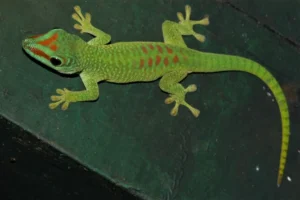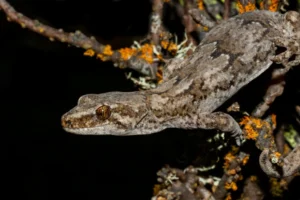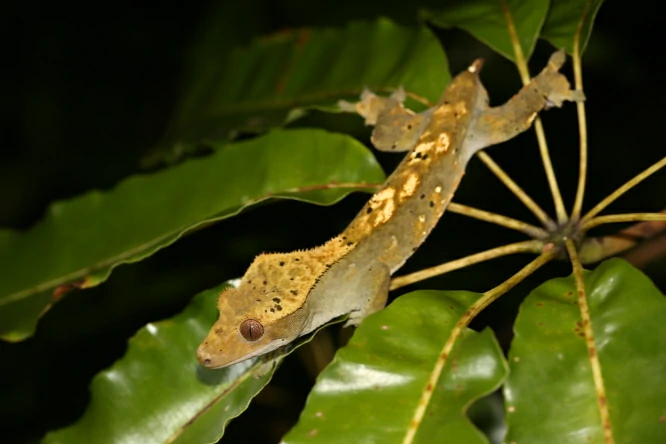Have you ever seen a gecko suddenly spring from one branch to another, or dash across a wall and disappear before you even blink?
It’s easy to think of geckos as just tiny wall-crawlers, but these little lizards are surprisingly athletic. Their movements aren’t random, they’re made for speed, agility, and yes… jumping. But how far can they really jump, and why do they do it?
Geckos can definitely jump, and some species can leap several times their body length. Jumping helps them escape predators, catch food, and move through tricky spaces. They use strong leg muscles, flexible bodies, and sticky toe pads to control their jumps, making them some of the most acrobatic reptiles around.
It’s not just about survival, watching a gecko jump is like watching a tiny gymnast in action. Their jumps are precise, calculated, and often impressive for such small animals.
Geckos Are Built for Jumping
If you look at it closely, a gecko’s body is perfectly made for jumping. They have strong, springy hind legs that push off with surprising power.

Their muscles are flexible, letting them coil and release energy quickly, like a tiny trampoline.
But leg strength alone isn’t enough. Geckos also rely on flexible bodies. Their spines and joints bend and twist midair, helping them adjust and land safely.
And don’t forget those sticky toe pads. While we usually think of them for climbing walls or ceilings, those pads also let geckos grab surfaces mid-jump or correct their landing if they misjudge distance.
Some geckos, like crested geckos, have extra-large toe pads that make sticking after a jump almost effortless.
Meanwhile, species like Tokay geckos rely more on leg power and body control to leap between high branches.
How Far Can Geckos Jump?
You might be surprised, geckos can jump really far compared to their size. Some species can leap three to ten times their body length in a single jump.
For a gecko that’s four inches long, that’s a jump of 12 to 40 inches; basically like a human leaping across a small room in one go.

Arboreal species, the ones that live in trees, tend to be the best jumpers. They often need to jump from branch to branch or across gaps in leaves.
Ground-dwelling species can jump too, but usually shorter distances, mostly to escape danger or catch prey.
A gecko’s jump isn’t just about leg strength. Takeoff angle, the surface they push off, and even tail position all matter.
A gecko can adjust its tail mid-jump to steer and stabilize itself, almost like a rudder on a tiny boat.
Why Do Geckos Jump?
Jumping isn’t just for fun, it’s survival. Geckos jump for several reasons:
-
Escaping predators: A quick jump can put distance between them and birds, snakes, or bigger lizards.
-
Catching prey: Some geckos leap to snatch insects that are out of reach, like a cricket midair.
-
Moving through their environment: Tree-dwelling geckos jump to get between branches, leaves, and vines. It’s often faster than crawling around obstacles.
-
Exploring territory: Sometimes geckos jump to check out new areas or find mates, especially during breeding season.
How Geckos Control Their Jumps
Watching a gecko jump looks effortless, but there’s a lot going on. Scientists have noticed that geckos:
-
Adjust leg position: They bend and stretch their hind legs to control distance and direction.
-
Use their tails: Their tail acts as a counterweight, stabilizing the jump and helping them land precisely.
-
Spread their toes: Sticky pads let them make tiny midair adjustments to land where they want.
A gecko’s jump is calculated, not random. They can change direction mid-jump and stick to surfaces that are vertical or even upside-down. It’s like they have a built-in GPS for leaping.
Jumping Vs. Falling
You might wonder how jumping is different from falling. A jump is a controlled push off a surface, while a fall is passive. But in both, geckos rely on flexible bodies, tails, and sticky toes to survive.

That’s why people are amazed when geckos land safely after dropping from ceilings or branches. Whether intentional or accidental, their bodies are built for airborne moments.
Jumping is just a more active, precise version of the same skill.
Pet Gecko Considerations
If you keep geckos as pets, their jumping ability matters. Here are some tips:
-
Secure enclosures: Geckos can jump out of tanks or cages, especially smaller species. Make sure lids are tight.
-
Safe climbing surfaces: Branches, ledges, or vines make jumps easier and reduce injury risk.
-
Soft landing spots: In taller tanks, adding substrate or padding at the bottom can prevent harm if a gecko misjudges a jump.
-
Observation: Watching them jump is fun and helps you see their capabilities so you can make their habitat safer.
Geckos’ jumps are amazing, but as caretakers, we can help them use those skills safely.
Are All Geckos Good Jumpers?
Not all geckos are extreme jumpers. Arboreal species like crested geckos, Tokay geckos, and day geckos are built for long leaps.

Ground-dwelling geckos, like leopard geckos, can jump, but usually shorter distances.
Even within arboreal species, age and health matter. A young, strong gecko may leap several inches easily, while an older or injured one might be more careful.
So, most geckos can jump, but some are naturally better at it than others.
Why Geckos’ Jumps Are So Interesting
Gecko jumps aren’t just about survival, they’re a glimpse into evolutionary genius. Each jump combines physics, muscle coordination, and sticky toe science.
The way they adjust midair, stick to walls, and land safely shows how nature solves complex problems in a small package. It’s also a reminder that even tiny creatures have incredible abilities.
When you see a gecko leap across a wall or branch, you’re watching something simple and extraordinary: a tiny athlete performing a move shaped by millions of years of evolution.
Conclusion
So, can geckos jump? Absolutely. Some species can leap several times their body length with precision and control.
They use strong legs, flexible bodies, tails, and sticky toes to make jumping a reliable survival tool. Whether escaping predators, catching insects, or moving around, jumping is central to their life.
Not all geckos jump the same, and factors like species, age, and health affect how well they leap.
But across the board, geckos are far more athletic and agile than most people realize. Watching them jump is like seeing a tiny gymnast perform incredible acrobatics, all without a safety net, yet landing perfectly every time.
Next time you see a gecko leap, take a moment to appreciate the design behind that jump.
Hi, my name is Ezra Mushala, i have been interested animals all my life. I am the main author and editor here at snakeinformer.com.

